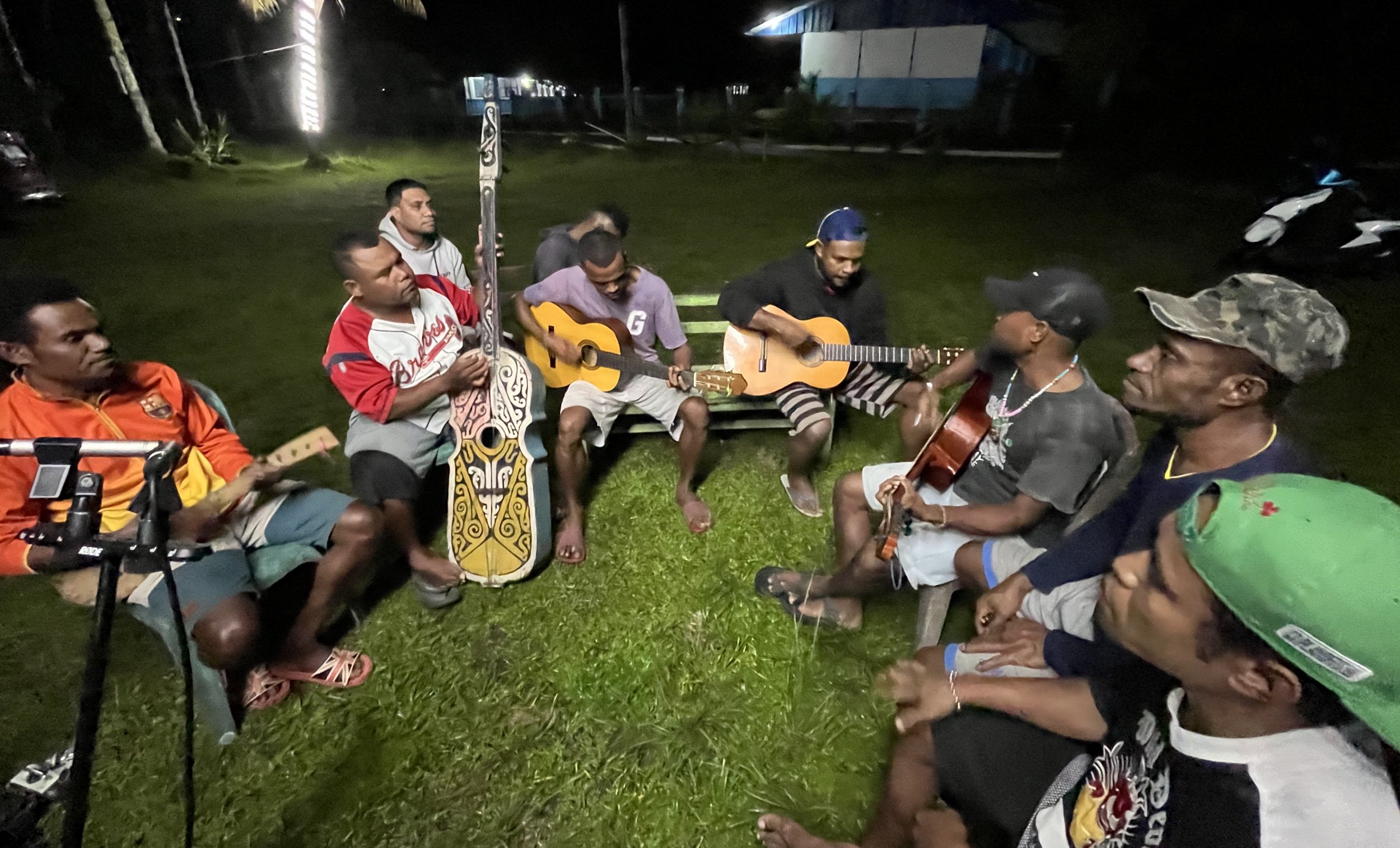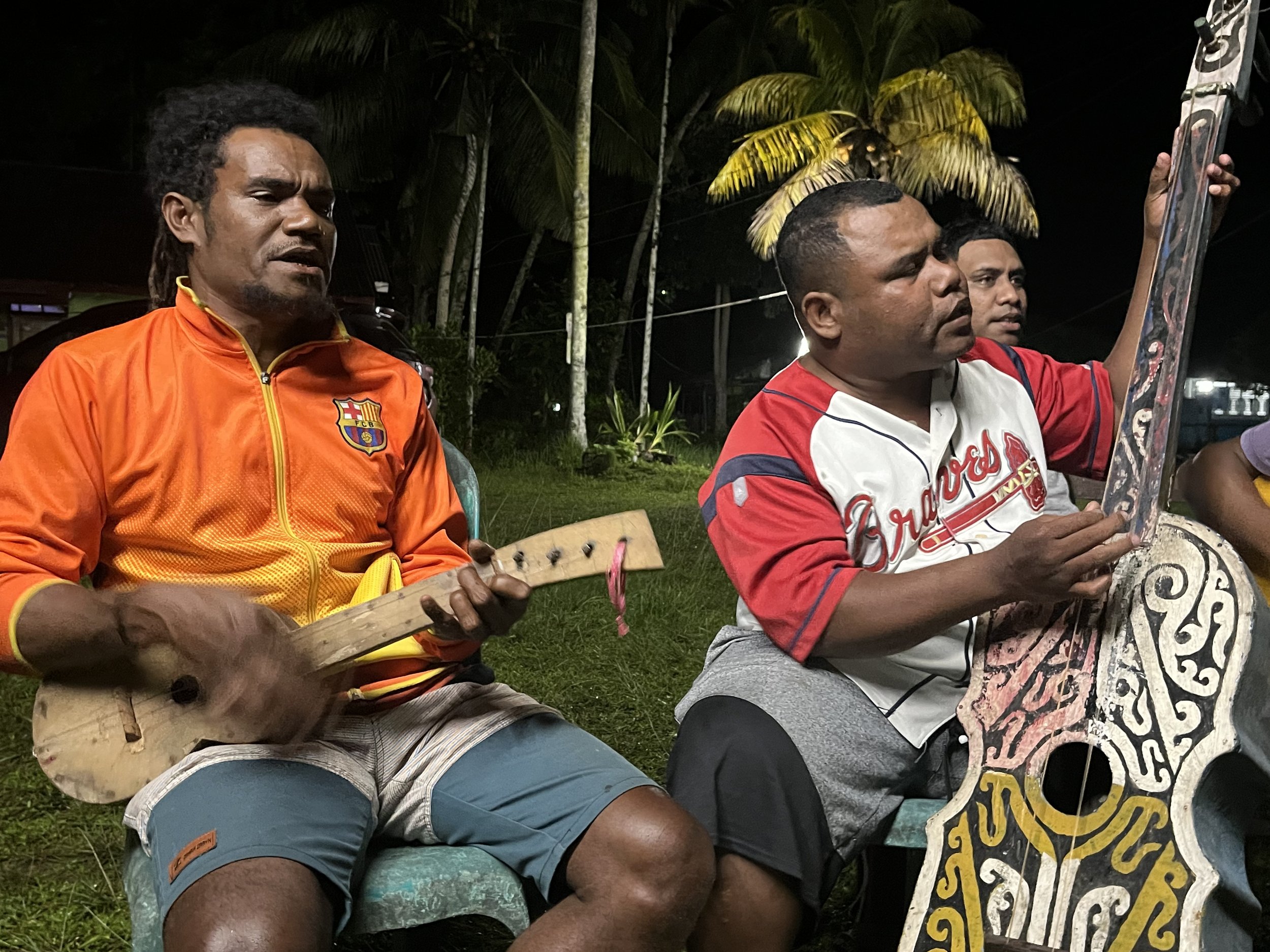Papuan Strings, Pt. 2: Yorbo, Arnold Ap, and Musical Solace in Biak
Sound: Yorbo (also, in different contexts, called yospan, or simply musik akustik.)
Location: Insrom, Biak Kota, Biak Numfor Regency, Papua
Everywhere I went in Papua, I met Biak people. These folks (orang Biak in Indonesian, sometimes called Biakers in English) and their homeland, the relatively small island of Biak in the waters of Papua’s Cenderawasih Bay, have indeed had an outsized influence on Papuan culture and history: The only Papuan to grace an Indonesian rupiah note is Biak’s own Frans Kaisiepo (Papua’s Suharto-era name, Irian Jaya, was partly dreamed up by Kaisiepo, who took the word “Irian” from the Biak language), and much of Papua’s pop music history was forged by folks with roots on the island (see the awesome and influential Black Brothers.)
For centuries, the people of this island have been anything but insular, as Biak’s traders, fishermen, and pirates set sail across wide swathes of what is now Eastern Indonesia. As Danilyn Rutherford and Philip Yampolsky write in their brilliant liner notes to Music of Indonesia, Vol. 10: Music of Biak, Irian Jaya, “The voyager has always occupied a special place in Biak society. Biaks tell of how their ancestors paddled their large outriggers west or south to Seram, Timor, and even Singapore in search of treasure and slaves.” As their influence spread far and wide, Biak people also came to assimilate elements of these outside lands into their own culture, from the Chinese porcelain that became the standard payment, or mas kawin, for bride-price to the titles they took on from the Sultanate of Tidore in the far-off Moluccas. Rutherford and Yampolsky share a fitting quotation from influential Biak-based missionary and anthropologist F.C. Kamma, who wrote that Biak people “find a thing strange only as long as it is not their own property, but as soon as it is ‘conquered’ the conqueror is assured of the same prestige that was enjoyed by the pirate of the past.” As Rutherford and Yampolsky succinctly put it, “the people of Biak assigned positive value to all such foreign elements, and put their stamp on each that they absorbed.”
All of this came to mind as I interviewed Pak Hendrik Baransano, a Biak native who played in Eyuser, a Biak-style string band formed by the late Ferry Marisan. We were speculating about the origins of string band music in Biak - could it trace back to World War II, when American soldiers fought the brutal Battle of Biak against the Japanese and later built a base and airfields there? Pak Hendrik recalled how, in his youth in Biak, they used to cast their radio antennas outward and catch broadcasts from Papua New Guinea, the independent eastern half of New Guinea proper where “stringbands” have long been a national phenomenon.
Despite its hazy origins, the modern tradition of Biak string band music was popularized almost single-handedly by one man, the legendary Arnold Ap. An anthropologist, musician, and cultural giant, Ap was born on Numfor, an island near Biak, and studied at mission schools on the island, where his father was a teacher. After studying at Papua’s most prestigious university, Cenderawasih University, Ap went on to join the faculty of anthropology there. Ap soon became a force not only in the growing field of Papuan anthropology, conducting fieldwork and documenting music and traditions across the area, but also as a musician and songwriter. In the early 1970s, Ap formed a band called Manyori with Jopie Youwe and Sam Kapisa - on the fantastic Papua Collecties site, Fred Gales writes that this group “was the first guitar band that performed in Protestant churches to accompany services of worship with self-composed Christian songs based on traditional Biak-Numfoor melodies.” In 1978, Ap formed the legendary band Mambesak with Kapisa, Yowi Kafiar, and Marthinny Sawaki, and their brand of string band-based folk and pop songs became a phenomenon across Papua.
Through these early Mambesak albums and a popular radio program based out of Jayapura, Ap brought together his skills as an anthropologist, collector, musician, and activist to help inspire grassroots string band scenes across all of Papua - these days, anywhere string band music is played in Papua, from the Asmat villages of the south to the highlands of Wamena, Mambesak songs are almost always front and center. Sadly, Ap’s efforts to foster and promote Papuan identity came to be seen as a threat by Indonesian authorities as early as 1969, when Ap protested against the infamous “Act of Free Choice” and was briefly jailed. In 1983, after becoming an icon of Papuan identity, Ap was jailed by Kopassus military special forces for suspected links with the Free Papua Movement, and in 1984 was shot and killed in what many believe was an intentional assassination by Kopassus.
Even after Ap’s death, his promotion of string band music and fostering of Papuan traditions and culture old and new continued to have an outsized effect on music back on his home island of Biak. In the eighties, a new kind of pan-Papuan dance craze began to sweep the island, likely encouraged by government and church officials as a wholesome, somewhat generic cultural artifact that could represent Papua (then Irian Jaya) on the national stage. This dance craze was called yospan, a merging of yosim, a dance from Papua’s north coastal Sarmi region, and pancar*, a dance from, where else, Biak. It seems the yospan fad has died down somewhat since its golden era in the eighties and nineties, but for a while it was everywhere in Biak, and string band music in general was most often played in this context, to accompany big social yospan dance parties held for everything from weddings to independence day celebrations.
On my trip to Biak, I was curious to see the place of string band music a quarter century on from Yampolsky and Rutherford’s recordings amidst the yospan fervor of the nineties. I’d seen lots of YouTube videos of string bands playing at the aforementioned mas kawin or ararem rituals, where family and friends get together to deliver the customary bride price (those Chinese porcelain plates) before tying the knot, so I made sure to keep an eye out for any weddings.
While I didn’t end up crashing any Biak nuptials, I was lucky to be hosted in Biak by the wonderful Suku Dani, a Papuan-born and bred missionary kid turned YouTuber (years earlier, I’d come across videos of him playing pikon and speaking Papuan Malay like a local and was immediately impressed.) Dani, as he’s known to most, has cannily shunned the influencer route in favor of working with environmental NGOs in Biak and generally being a cultural ambassador for Papua. Together we stopped by a few sanggar, or arts communities, and chatted folks up about string band music in Biak, though weren’t able to get a recording session together until my last night in Biak, when Dani’s friend Ambi told us some friends of his could share their music for us.
It was a chill affair - the musicians were a group of twenty to thirtysomething Biak guys who’d been playing together for years. Whether it was for a wedding or a funeral, they’d get together and jam, a practice they called yorbo. This yorbo session started off a bit shakily - not everyone knew every song - but as they played through a handful of spirited medleys, voices started to gel and those beautiful Biak harmonies started to ring out with increasing confidence.
Ambi had told us that after the recording session, he’d be going to a kind of wake, what people in Biak call tiga malam (three nights) or acara duka (grieving ritual.) In Biak tradition, a death in a family prompts an entire community to come together - neighbors, friends, extended family - and gather at the house of the deceased as the family grieves. To raise the grieving family’s spirits, musicians from amongst the community gather and play string band music - yorbo as a soothing balm for the mourning. We were welcome to join, Ambi told us, to see and hear yorbo in another context.
As we arrived at the nearby neighborhood of Ujung Pagar, it was nearing midnight, but the street was lined with folks sitting in plastic chairs, sipping coffee and chewing betelnut. In the front yard, a dozen men were huddled around a big stembas, homemade guitars and ukulele in hand, singing up a storm. We shook a few hands, gave some rice and cooking oil we’d brought to the family, but otherwise folks paid us no mind. Hoping not to intrude, we pulled up chairs and looked on as the group took turns with ramshackle medleys - one song merging with another as somebody called out a new verse over the same looping handful of chords. Homemade guitars jangled out of tune, songs occasionally petered out as folks forgot the words, but the aim was clearly not performative perfection. The yorbo was clearly succeeding at its goal, though, as spirits remained high despite the circumstances.
We stayed for only half an hour or so, before it was time to move on for the evening - as we left, the band were midsong, voices lifting with hope. I may not have found the same yospan scene I’d read about, or even a wedding to crash, but I’d had my own hopes confirmed: decades on, in the diaspora and at home, Biak string music remains vital.
*The term pancar, Ruthorford and Yampolsky write, comes from pancar gas, the Biak term for a jet, and the dance’s movements are said to imitate a stalling airplane such as the Dutch fighter jets that flew over Biak towards the end of Dutch rule in the 1960’s. Interestingly, I’ve also recorded a similar story in North Sulawesi’s Sangihe archipelago, where orkes string bands very similar to Papua’s play music to accompany a social dance called ampa wayer which also is said to refer to and mimic the movement of war planes (in Sangihe it’s said to reach back to the Japanese fighter planes of World War II.) I’ve always wondered if there’s a connection, both between the string bands and the dances - Sangihe and North Sulawesi in general has a role similar to Biak in that they often sent missionaries, priests, and doctors across East Indonesia - could there have been some cross-cultural linkages happening?
***
This post is in memorial of Amelia Msen, whose life was honored at the tiga malam gathering. Thank you to Bu Amelia’s family for the gracious invitation and for sharing their moment of musical solace with us.
Thank you to Dani, Ambi, and to the musicians of Ujung Pagar and the Baitel band of Kp. Insrom.






